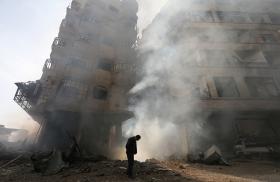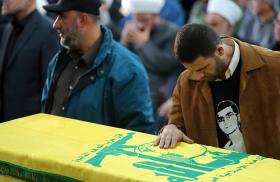A New Intifada? The events of the past five weeks are not a repeat of the Palestinian Intifada of 1987–1990, a spontaneous uprising that caught both Chairman Yasir Arafat and Israel equally by surprise. Rather, the current uprising is a confrontation imposed by Arafat on the Palestinian street. Three major elements of the original Intifada are missing in the current situation:
1) The countryside, a backbone of the original Intifada, has so far opted out of the current struggle;
2) the population of east Jerusalem has distanced itself, to the extent that the Tanzim has had to send people from Ramallah and the refugee camps into Jerusalem in order to engineer confrontations. Seen from this angle, the shooting of Israeli guards at the National Insurance Institute in east Jerusalem is a signal to Jerusalem Arabs that Arafat will not permit them to remain on the sidelines;
3) the lower middle classes, a prominent player during the original Intifada, are absent. While thousands may participate in funeral processions, very few (including very few students) join in confrontations with Israeli soldiers at the major flashpoints; the size of these confrontations rarely exceeds a few hundred.
Arafat and His Goals In many different situations over his long career, Arafat has proven adept at proceeding from an unsatisfactory initial agreement and utilizing the opening provided by the agreement to achieve much wider strategic gains. As early as 1993, Arafat viewed the Gaza-Jericho agreement as providing just such an opening, and he will probably attempt to use any future "armistice" agreement as another such springboard.
At the Cairo Arab League summit, Arafat spoke of "waves" of Intifada–not continuous upheaval, but rather an ongoing instability accompanying the process, maintained by fluctuating levels of violence. Arafat is devoted to the long-term objectives of the Palestinian cause, as distinct from the interests of the Palestinian people. This means that while he would prefer to build a Palestinian state with Israeli consent, he will not do it at the price of burying any Palestinian rights or renouncing any Palestinian claims. His goal in engineering the current violence is to avoid a deal which would force him to surrender those claims. Israeli prime minister Ehud Barak’s proposals of "end of conflict" and "end of claims" threatened precisely this principle, and had Arafat accepted them, they would have reduced him to the level of politician rather than the historic leader and visionary he sees himself as.
The strategy chosen by Arafat includes partially undermining his own organs of power (i.e., his numerous armed security forces) in order to allow the resurgence of a parallel structure of "revolutionary" power–namely, the Tanzim. There is no validity to the argument that Arafat has lost control of the street or of the Tanzim. To accept this claim, one must accept the preposterous idea that Fatah is in open revolt against its leader and that Palestinian television and radio stations have somehow been taken over by the "rebels." On the contrary, the Tanzim is not rebelling against Arafat; Arafat is using the Tanzim as a foil to Palestinian Authority (PA) security organs. This dual approach is akin to Arafat’s insistence on maintaining parallel structures between the Palestinian Liberation Organization (PLO) and the PA.
Arafat’s inter-Arab strategy is similar to the strategy he used in the late 1960s, when he operated from bases in different Arab countries. During that period, his strategy was "entanglement"–sortie from a sovereign Arab land, attack in Israel, and return to base, with the hope that Israel would blame the Arab host country and draw it into the confrontation. Now, Arafat’s strategy is "spillover"–create a bloodbath that will cross the border, inflame the Arab street, and force Arab governments to react. The Arab League summit showed both the appeal and the limitations of this strategy, in that no Arab state showed itself willing to be dragged into a war on behalf of the Palestinians.
Hamas Hamas is not in practice a cohesive, homogenous force; the movement exhibits great divergences in different regions. To the extent the Hamas is in league with the PA, this cooperation is restricted to the framework of the local committees recently established by the Fatah, part of the parallel structure erected as an antidote to the PA. In the Gaza Strip, Hamas is fairly controlled and domesticated, and is understood not to carry out operations inside Israel. Most of the Lebanon-style operations have been carried out by Muhammad Dahlan’s people or in connivance with them. As for the West Bank, the arrests of the past years have shattered the Hamas power structure, and not even the recent release of activists from PA prisons will immediately restore the organization to its former strength. The unknown factor is Damascus-based Hamas, from whom we have heard very little.
Israel At present, Israel’s response to the violence has been very limited and restrained. The Israeli Defense Forces (IDF) are deployed in a way that maintains a "soft siege"–containing the violence without conducting offensive measures. Israel is implementing this strategy both because the Palestinians do not present the kind of targets likely to influence Arafat and because the Israelis are careful not to provide Arafat with an incident that would cause an inter-Arab eruption in the Palestinians’ favor. Most importantly, Israeli policy is constrained by the fact that the only effective target for military action would be Arafat’s inner circle, and for obvious reasons Israel is more than reluctant to pursue that option.
The Future The past month’s events have proclaimed the death of the peace process in the Oslo format. Oslo is never mentioned anymore by Palestinian spokesmen. Yet it must be replaced by another process, one that is incremental by its very nature. Now, no single agreement can resolve the Israeli-Palestinian dispute. Any future deal will have to be significantly less ambitious than the one attempted at Camp David. The "end of conflict" is not in sight, nor does Camp David offer an exit from the present crisis. Arafat would be willing to accept less than Israel’s Camp David offers, as long as he is not required to renounce Palestinian claims. In order for any deal to happen, Arafat is likely to demand that he is recognized as a head of a state, even if the state’s borders remain undefined. Arafat will never settle for less than full sovereignty on the Temple Mount, and would probably not be willing to concede sovereignty over the Western Wall to Israel either. For these reasons, most issues will probably be deferred. Similarly, Israel is not likely to concede Palestinian claims in the Jordan valley and will reject Palestinian demands for control of border crossings. It is likely that Israeli settlements will be consolidated into blocks for security reasons. For the time being, we will continue to witness "controlled" violence to maintain aggregate instability.
This Special Policy Forum Report was prepared by Rachel Stroumsa.
Policy #293



